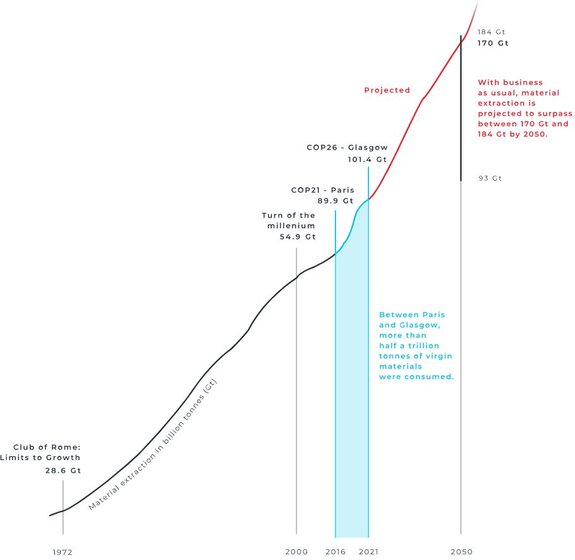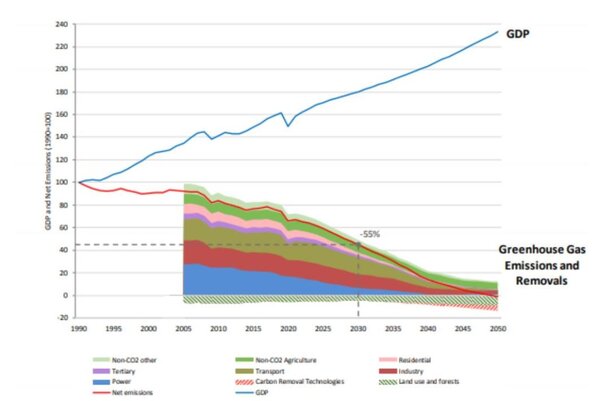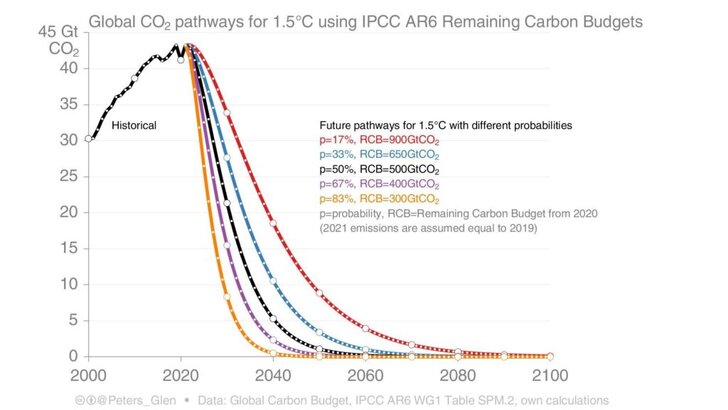Since the IPCC report in August 2021, voices defending possible green growth or decoupling are becoming increasingly rare. The word green growth is no longer really used by politicians, even if some still dare to speak of responsible growth, production ecology, etc.
After a year 2020 where we had observed a significant decrease in global emissions, some people started to dream. “You see, it’s possible to have lower emissions!”. Certainly, but with a global recession due to Covid, because in 2021, global growth has picked up again, accompanied by an almost identical increase in emissions.
Every year that passes is a year lost in meeting our climate commitments. False hopes are systematically dashed by the figures which remind us that physics does not care about lies and promises. After defining what decoupling is, we will demonstrate in figures that green growth is a zombie theory and that it is urgent to move on.
Defining green growth and decoupling
To be sure we are talking about the same thing, it is first important to agree on a definition of green growth and decoupling.
In the vast majority of cases, green growth is defined by a decoupling, i.e. an economy where we have both economic growth (increase in GDP) and at the same time a decrease in CO2 emissions. Sometimes this green growth is linked to a visible decrease in resource consumption and other environmental impacts, but this is much rarer in the scientific literature and in the debate.
To achieve true decoupling, this green growth must meet several criteria :
- Absolute decoupling : the 2 values must move in opposite directions. For example, a small increase in emissions is still not a reduction. Some people are happy with a 0.5% decrease in emissions, with a growth of +0.3%…
- Net : this decoupling must take into account imports and exports (rather take into account the carbon footprint than territorial emissions).
- Long term : this decoupling must be observed over several years or even decades, not just over one or a few years. For example, Austria decreased emissions by -0.6% in 2006-2010 and -1.6% in 2011-2015, but emissions became positive again by +0.3% in 2016-2019.
- Geographical area: this decoupling must be global and not by country (CO2 has no borders…). However, it may be interesting to look at the national scale, as the High Council for the Climate has done with France, judging that the country should reduce its emissions 3 times faster.
- Fast: there is a very important time constraint to respect our climate objectives. The carbon budgets to meet the Paris Agreement (whether +1.5°C or close to +2°C) are shrinking year after year, and we can see that there is little room for maneuver.
Fast decoupling, but how fast?
For a decoupling to allow us to have a truly green growth, it should at least allow us to respect the commitments of the Paris Agreement. For this, there is a carbon budget to respect to limit warming to +1.5°C, and another for +2°C.
The net amount of CO2 that humans can still emit while limiting a specific degree of warming to 1.5°C in the IPCC report is about 500 GtCO2 . The table below provides an overview of the latest estimates, for different temperature limits and probability levels:

Joeri Rogelj, lead author of the 6th IPCC report, had given a full explanation of these famous budgets. One obvious fact is that the remaining budgets are small, our current emissions of about 40 GtCO2/year are rapidly depleting them, and without rapid reductions, we will explode the budgets (and thus exceed the +1.5°C and +2°C limits).

A quick conclusion from reading these different graphs: at the current rate, we had last year about 10 years to go before reaching a global warming of +1.5°C. When we know that the UNEP asked for a decrease of -7.6% per year in 2019 to limit warming to 1.5°C, we are two years later in a dead end.
(Truly) green growth has never existed
Given the criteria previously explained, has green growth ever been observed? The answer is no. Not in absolute, or not long enough, or not strong enough, or only locally. There have been decouplings, but never the right one.
Some interesting studies have demonstrated a partial decoupling. For example, this post from the BreakThroughInstitute (BTI) had been pretty much shared by green growth advocates, claiming that there was a decoupling and that we just needed to step it up. Or the study by Le Quéré & al. Finally, this very important meta-analysis of 835 articles on decoupling by Habert & al. where some decoupling is observed at the national level. But in the end, none of them meet the criteria explained above.
With Covid, the only year since the 2008 financial crisis when we lowered our emissions, some thought the impossible was possible. This was without counting on a historic recession the same year, and especially on the rebound observed in 2021.
2022, official death of green growth and decoupling
In 2021 and globally, fossil CO2 emissions increased by 4.2% (3.5%-4.8%) compared to 2020 to reach 36.2 billion tons, a level close to 2019 (36.7 Gt CO2).
But growth of fossil fuels…
To reach carbon neutrality in 2050, and thus a supposed green growth or economic decoupling, there are no 150 solutions: end our dependence on fossil fuels. Welsby & al. tell us that “To maintain a 50% chance of reaching a temperature of +1.5°C, 90% of the known coal and 60% of the known oil and gas must remain in the ground.
The year 2021 was a year of very strong growth for these three fossil fuels:
This will not surprise anyone. Xi Jinping, who had announced China’s carbon neutrality by 2060, announced on August 4, 2021 the reopening of 15 mines located in the north and west of the country. Joe Biden, despite the worldwide enthusiasm at his inauguration, continues the “non-negotiable lifestyle” of Americans. The same is true for the Europeans, who continue to pursue their objective of green growth, which has never happened and will, barring a miracle, never happen.
The environment is not only about CO2
Environmental issues are not just about CO2 emissions. They concern all greenhouse gases, but also biodiversity, planetary limits, etc.
Several other indicators show that green growth is a sham. We do not observe any economic decoupling when all GHGs are taken into account, and it is the same for biodiversity, which is in free fall:
Recycling for dummies
Another popular idea is that recycling would enable green growth and decoupling. A kind of circular economy, blue, white and especially red.
In just 50 years, global material consumption has almost quadrupled, outpacing population growth. At the time of the Club of Rome’s 1972 report Limits to Growth, the world was consuming 28.6 billion tons. By 2000, this figure had risen to 54.9 billion tons, and by 2019, it has surpassed 100 billion tons.

Since the Paris Agreement, the world economy has consumed 500 billion tons of virgin materials. What is the final recycling rate? 8.6%. You read that right: 8.6%. These figures go completely against green growth and a possible economic decoupling.
Limits of green growth
The IPCC Working Group 2 report released in February 2022 confirms that it is impossible to have an ecological transition without social justice. We have known for several decades now that GDP does not meet social criteria. Among the many, many criticisms we can make of GDP, here are a few:
- Does not allow for the analysis of inequalities within a country
- GDP growth makes little sense as an indicator of social progress. Social policies focused on use value, care, public provisioning and decommodification would improve social justice but may well reduce GDP growth (Hickel)
- Is a wealth indicator that excludes the inclusion of certain demonetized activities performed by women (Meda & al, 2011)
- Doesn’t give any indication of raw material inventories, and we continue to act as if they are infinite.
To learn more about the limits of GDP, you can read this interview with Timothy Parrique, and/or the dozens of books devoted to this question. The literature is extremely rich on the subject and is more than sufficient to understand that GDP alone cannot be a good indicator for the challenges of the 21st century.
Green growth and decoupling: why are we still talking about it?
If we still hear about green growth in 2022, it is simply because some people have a political interest in not changing the economic system. The fact that some countries in the South want growth is perfectly normal and compatible with a sustainable world. But it is unjustified for the countries of the North, which are bogged down in this logic of always more, even if it means perpetuating a colonialist economic system that exploits the countries of the South.
This is the case for the European Union, which is still aiming for 3% growth with -55% emissions. I was already questioning these incantations full of wishful thinking in 2020 and since then, no miracle has happened.

The curves represent what they hope for, which contrasts slightly with the graphs shown earlier.
Source
The European Union is not alone in living in a parallel world where green growth is possible. For example, the World Bank talks about “inclusive green growth”. As for France, the government continues to rely on green growth and to bank on the 8th Sustainable Development Goal, which is nevertheless highly criticized. But how is all this possible? Thanks to carbon neutrality in 2050.
Net-Zero 2050: the untenable promise
There is still confusion about the terms zero emissions and net zero. The goal of carbon neutrality is net zero: a state of equilibrium between man-made greenhouse gas emissions and their removal from the atmosphere by man or by his actions. This does not mean not emitting, but offsetting as much as the emissions emitted.
This means that you could potentially continue to increase greenhouse gas emissions if you found a way to offset them. This is one of the dangers of this famous carbon neutrality 2050, achieved by technological innovations or by planting trees. This type of scenario is highlighted in the Paris Agreement, and by the various IPCC scenarios, including the only one that would allow us to limit warming to +1.5°C.
This is obviously a scandal, since neither tree planting nor carbon sequestration and capture live up to their promises. This is how we end up with sorcerer’s apprentices who want to inject aerosols into the stratosphere (SAI). For your information, here is what the effort to limit warming to +1.5°C looks like, without a technological miracle:

Green (De)growth
Any reasonable person would know that green growth is a pure illusion just by reading these curves. Ask a politician or an ecomodernist the same thing, and he will tell you that all you have to do is plant trees and invent a machine to suck out the CO2.
Debates about green growth and decoupling are not new. They have been going on for at least two decades, and since the 2000s the scientific papers keep piling up and driving the nail into the coffin. Green growth has never happened and probably never will. Decoupling has still not been achieved and every year that passes brings us closer to the precipice.
Should we expect anything else from economic forecasting? Of course. The IPCC has just mentioned in its 2nd working group degrowth as a possible solution for the first time in its history, the 3rd part will give a synthesis of the possible paths.
Should we expect anything else from countries, both nationally and internationally? Obviously. Starting with the countries of the North who still refuse to play their part in a social and fair ecological transition.
The last word
As the IPCC pointed out in August 2021, each ton of CO2 emitted contributes to global warming. Given the figures presented in this article, the debate around green growth and economic decoupling is now akin to a climate inaction discourse. The eco-modernists and other Elon Musk will make believe like in the movie Don’t Look up that there will be technological solutions, while the disasters caused by global warming will accumulate.
The debate is over. The burden of proof now lies with the believers in green growth and decoupling. Debating it would be a waste of time, as Brandolini’s law has already caused enough damage.
It is time for economic and political leaders to face the facts and open their eyes. Do they want to play Russian roulette with our future and that of our children, or change the economic system?



